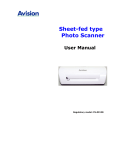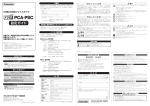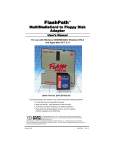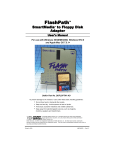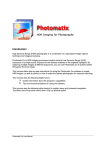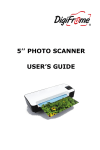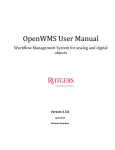Download Easypix 5.2 Specifications
Transcript
0 Contents 1. Introduction ................................................................. 2 2. Preparation ................................................................. 3 Package Contents ............................................ 3 Scanner Overview ............................................ 4 3. Installation & Operation .............................................. 5 3.1 Initial Setup ................................................ 5 3.2 Power on the Scanner ............................... 6 3.3 Scan an Original ........................................ 8 3.4 Power off the Scanner ............................... 9 4. Connecting to a Computer ........................................ 11 4.1 How to connect the scanner to a computer ……………………………………………………11 4.2 Disconnecting the scanner from a computer ....................................................................... 13 5. Maintenance ............................................................. 14 5.1 Cleaning the Roller of the scanner……....14 5.2 Calibrating the scanner ……………………15 5.3 Cleaning the Image Sensor ..................... 16 6. Troubleshooting ........................................................ 17 6.1 Frequently Asked Questions .................... 17 7. Arcsoft BizScanner ................................................... 19 7.1 Install BizScanner………………………….19 7.2 Run BizScanner……………………………21 7.3 Start to use BizScanner…………….……. 22 7.4 System requirements…………………….. 31 8. Specifications ............................................................ 32 1 1. Introduction Congratulations on your purchase of the scanner. Now you can scan and store your printed photos directly to your memory card or flash disk without connecting to any computer. If you want to store your photos directly into your computer, just connect the scanner with SD card to the computer. Before you install and operate the product, please take a few minutes to read through this manual. It provides proper instructions for you to install, operate and maintain the product. Precautions Keep the product out of direct sunlight. Direct exposure to the sun or excessive heat may cause damage to the unit. Do not install the product in a humid or dusty place. Be sure to use the proper AC power source. Place the product securely on an even, flat surface. Tilted or uneven surfaces may cause mechanical or paper-feeding problems. Retain the product box and packing materials for shipping purposes. System Requirements Free USB 2.0 port ® Windows XP ® Windows Vista™ ® Windows 7 (32 / 64 bit or later version) 2 2. Preparation Package Contents Scanner CD QSG Roller Cleaning Tool Sensor Cleaning Swab Calibration Card AC Power Adapter USB cable 3 Scanner Overview 4 3. Installation & Operation 3.1 Initial Setup 1. Connect the plug on the power adapter cable to the power connector on the scanner. 2. Plug the power adapter into a power outlet. 3. Insert a memory card into the memory card slot or a flash disk into the flash disk slot. Note : The SD card is the high priority when you insert the SD card and flash disk together. 5 3.2 Power on the Scanner 1. Press and hold the Power button for about 0.5 seconds. The power indicator green light blinks. 2. Wait until the power indicator stops blinking then change to orange and stays on to indicate the scanner is ready. 6 The indicator light patterns represent function status as follows: Light 1. Green Blinks Function Status The scanner is power on and initiating. 2. Orange Steadily on The scanner is ready for use. 3. Orange Blinks Continuously Initializing system and memory card. Please wait until the initialization process is complete before using the scanner. Busy scanning and storing image files. Please wait until the process is complete before scanning another original. Sensor cleaning in progress. Please wait until the process is complete before performing any operations. Paper jam. Press the Custom button for about 0.5 seconds; the scanner will back out the original so you can remove it from the input slot. Memory card error. Remove the memory card to clear this error status. Calibration failed. Error indication only. 4. Red Blinks 5. No light The scanner is powered off. 7 3.3 Scan an Original 1. Insert your photo or name card with the side to be scanned facing upward and in correct orientation, place the left edge of the original against the left edge of the feed slot, and then adjust the guide lever so that it is against the right side of the original. Do not apply any force to the original. 2. Gently push the original into the feeding slot and let go when it begins to feed into the slot. 3. When the scan is completed, the scanner will automatically create a folder titled “Photo1” on your memory card or flash disk, which will hold the first 9999 scans. Then “Photo2” folder will be created for the next 9999 scans, and so on. (Each scanned image is given a file name with the prefix scan followed by a 4- digit sequential number in the order the images are stored. For example, IMG 0001.jpg, IMG 0002.jpg, etc.) Note: Do not remove the memory card or disconnect the power supply while the indicators are blinking. This scanner only supports output images in JPEG (.jpg) format, and the date/ time attribute will not be added. If the memory card is near full (lower than 1MB), the power indicator light blinks. Use another card or delete some files on it if necessary. Insert only one original at a time, and insert the next original only when the previous one is done and the blinking has stopped, otherwise the scanner may malfunction. 8 3.4 Power off the Scanner After all originals were scanned, press and hold the power button until the indicator blank. Now you can safely disconnect the power and remove the memory card or flash card from the scanner. Important: 1. Insert only one photo at a time, and insert the next one only when the previous one is done, and the indicator light stops blinking. Otherwise, the scanner may malfunction. 2. The acceptable paper size is 2”x 2” ~ 4” x 6”. 3. Do not use the following types of originals for scanning; otherwise the scanner may malfunction or cause the original to jam in the slot. 4. Originals thicker than 0.5mm Originals with either side shorter than 50mm(below 2”) Originals with lots of black or dark colors Originals with dark colors surrounding the edges Transparencies(filmstrips, celluloid, etc.) Printed images (pictures on newspapers, magazines, etc.) Soft and thin materials (thin paper, cloth, etc.) Originals that exceed or below the acceptable size The scanner has a built-in cropping function that is capable to detect and crop the edges of an original. 9 The max cropping size is 1.5mm per edge, as illustrated below: 5. If the photo is incautiously skew in the feeding slot, the four edges of the scanned image will become dark as illustrated. Max. 1.5mm 10 4. Connecting to a Computer You may use the scanner as a memory card reader by connecting it to the computer through the USB cable, so that you can freely copy, paste or delete files to and from the memory card. The images in the card can also be downloaded to the computer by other computer devices. 4.1 How to connect the scanner to a computer 1. Connect the plug on the power adaptor cable to the power connector on the scanner. 2. Insert a memory card or flash disk that contain your scanned images into the memory card slot. 3. Connect the mini end of the USB cable (included with scanner) to the Mini USB connector on the scanner. 11 4. Power on your PC, and then connect the large end of the USB cable to a USB port on your PC. 5. Press and hold the Power button for 0.5 seconds. 6. When the scanner connects successfully with a computer, a Removable Disk (F) (F represents the removable drive letter) will be shown in Windows Explorer. If a memory card or flash disk is inserted to the scanner, the Removable Disk will be replaced with the name of the memory card or flash disk. 7. After your scan, a folder titled PHOTO1 is added to the memory card or flash disk and the scanned image will be saved in JPEG file format. Each scanned image is given a file name with the prefix scan followed by a 4- digit sequential number in the order the images are stored. For example, IMG0001.jpg, IMG0002.jpg. If the file name reaches IMG9999.jpg in the Photo1 folder, a new folder titled Photo2 will automatically be created to store subsequent new files, and so on. 8. You can now view or edit the files on the memory card or flash disk using your own graphic editing software. 12 4.2 Disconnecting the scanner from a computer 1. On the Windows System Tray, click the hardware removal icon. 2. Click the ‘Safely remove USB mass Storage device’ message with the corresponding Drive. 3. When the ‘Safe to Remove Hardware’ message appears, you can safely remove the scan engine’s USB cable. 13 5. Maintenance 5.1 Cleaning the Roller of the scanner If the scanned image has lines or photo has dust, clean the roller by supplied roller cleaning tool. Using only the recommended and supplied tools. Follow the instructions of Cleaning the Roller on the preceding section to clean the roller. 1. Connect the power supply to the scanner. 2. Insert the SD card or flash disk. 3. Press and hold the power button for about 0.5 seconds to power the scanner on. 4. Press the Custom button and release immediately. 5. Place the supplied roller cleaning tool on the feeding slot. 6. The cleaning tool will be brought into the feeding slot automatically, and the cleaning process will begin. 7. When the cleaning process is completed, the cleaning tool will be ejected from the feeding slot. 14 5.2 Calibrating the scanner If the scanned image color looks unnatural, the scan engine may need calibrating in order for the sensor to resume its original precision. To calibrate the scan engine: 1. Connect the power supply to the scanner. 2. Insert the SD card or flash disk and move the guide lever to the end of right side. 3. Press and hold the power button for about 0.5 second to power the scanner on. 4. Press and hold the Custom button until the indicator LED blinks. 5. Insert the calibration card to the feed slot in 5 seconds. 6. The scanner starts calibrating. 7. The calibration chart will move and stop some time then reject when calibrate done. Notice : Always keep the calibration card clean and avoid dirty, scrape or wrinkle that will affect the calibrating result. 15 5.3 Cleaning the Image Sensor If the scanned image looks fuzzy or there are strange stripes on it, the image sensor may need cleaning in order for the sensor to resume its original clean. To clean the image sensor: 1. With the scanner powered off and disconnected from the power supply, insert the sensor cleaning swab into one end of the input slot. 2. Gently slide the sensor cleaning swab back and forth from one end of the input slot to the other five or six times consecutively. 3. Remove the sensor cleaning swab, store it in a safe place and protect it from dust. 16 6. Troubleshooting If you have problems with the operation of the product, please check the following troubleshooting hints. 6.1 Frequently Asked Questions Question: There are strange lines on the scanned image, or the image is not clear. Answer: Check the following: Are there scratches on the original, or is the original clean? Remove any stains or dust from the original before scanning. Has the scanner been used for a long period of time without cleaning and calibration? Follow the instructions for "Cleaning the Scanner" and “Calibrating the Scanner", and then try again. Question: Answer: Question: Answer: The original gets stuck halfway in the feeding slot. Press the Custom button. The scanner will back out the original so you can remove the jammed original from the output slot. The status indicator blinks rapidly and no scan is possible. Check the following: Is the memory card inserted properly into the memory card slot? Re-insert the card and try again. Is the SD card locked (set to write-protect)? Unlock the card. Is the memory card full? The indicator blinks when the free space on the memory card is below 1MB. Use another card if necessary. Make sure the memory cards are in FAT or 17 FAT32 file formats only, not NTFS or any other file format. Did you insert the next original before the scanning process of the previous one was completed? Power the scanner off and back on and try again. Make sure that you scan the next original only after the scanning process of the previous one has completed. Does the length of the original exceed the maximum acceptable size? Question: The scanner feels warm to the touch. Answer: It is normal for the scanner to emit a small amount of heat (around 30-45 degrees Celsius) after prolonged use. However, if there are strange odors coming from the scanner or the scanner feels hot to the touch, disconnect the scanner immediately from the power supply or the computer. Question: Photo with dark edge cropping problem Answer: For a very darkedge(edges) photo, the scanner will not read the dark portion and will be cropped away. This kind of photo is not suitable for scanning. 18 7. Arcsoft BizScanner This simple application uses advanced OCR technology and scans the images of your business cards. It quickly and easily captures contact information from business cards and adds it to the application's database, saving you a great deal of time and effort by eliminating the need to manually type in names, phones, and other key information. BizScanner also provides convenient tools for you to manage all business cards. With just a few clicks, you can synchronize the application's database with other programs, such as Microsoft Office Outlook and so on. 7.1 Install BizScanner 1. Insert the installation CD into the CD-ROM drive and click ‘BizScanner’ and start to install BizScanner. 19 2. Follow the installation wizard step by step. 3. Install completely. 20 7.2 Run BizScanner There are several ways that you can launch BizScanner: Double click ‘BizScanner’ icon on the desktop or right-click the icon and select “open”. Click Start-> All Programs-> ArcSoft BizScanner-> BizScanner. 21 7.3 Start to Use BizScanner 1. Input Business Cards Input - Switch to "Input Business Cards" to quickly and easily capture contact information from business cards. 1.1 Input business cards main screen: 22 1. 2 Toolbar The Toolbar provides the following functions for you to input business card images: Import from BizCard Scanner - Import images of business cards from a professional BizCard scanner. Before using this function, make sure that a BizCard scanner is properly connected to your computer. Import - Import existing images of business cards from your local disk. Choose "Import from Folder" or "Import from Files" from the drop-down list. Language - Select the language of the business card from the drop-down list. BizScanner recognizes multilingual business cards. Thumbnail Display Displays thumbnails of all imported business cards. Select a thumbnail and detailed contact information of that card is displayed. To remove a specific business card before importing it to the database, click the Delete icon located on the bottom right corner of the selected thumbnail. 23 Contact Information Displays detailed information of the selected business card. Any characters that do not appear correct are highlighted. Modify any information and select a category for that card from the drop-down list. If the card does not fit into any of the existing categories, use the "New Category" button to create one. The thumbnail of the active business card is also displayed in this area. Use the "Rotate Left" or "Rotate Right" button if the image is not properly placed. When all information of the business card is correct, click "Confirm" to add it to the database. 24 2. Manage Business cards Manage - Switch to "Manage Business Cards" to manage the application's database and preview all imported business cards. 2.1 Manage business cards main screen: 25 2.2 Toolbar The toolbar provides several functions for you to manage the database. Email - Send selected business cards as email attachments. For each card, the original image and a vCard file are attached. Export - Export the selected business cards as a specified format as listed in the drop-down list. vCard - Export the selected business cards as vCard files, a file format standard for electronic business cards. They can be exchanged in various ways. Outlook Address Book - Add contact information of the selected business cards into the address book of Microsoft Office Outlook. JPEG - Export the original images of the selected business cards as JPEG files. Excel - Export the contact information of the selected business cards and save it to a CSV file, a file format used for the digital storage of data structured in a table of lists. 26 Backup & Restore - Select "Backup" from the drop-down list to save the selected business cards as a backup. If you delete any card by mistake, use "Restore" from the drop-down list and import all backup cards to the database. Search - Sort business cards by keywords. BizScanner searches all business cards and displays the results in the Card Display area. Category Categorizes all business cards into different groups when importing. Select each category to see all cards under that group in the Card Display area. Use the following buttons to manage these categories: New Category - Click to create a new category. Enter the name of the new category and press "Enter" to confirm. Newly-added categories are placed before the category named "Others." Delete Category - Click to remove the selected category. BizScanner’s default categories cannot be deleted. 27 Card Display Provides two modes for you to preview all business cards. More than one card can be selected at the same time. List View - Displays detailed information in a table format. E-mail and website addresses are displayed in hyperlink format. Click to send an e-mail or visit the website. 28 Thumbnail View - Displays business cards as thumbnails to provide a direct way of viewing contact information. In each view, you can also right-click the business card to display an additional menu: Move to Category - Move the selected business card to another category. 29 Edit - Modify the details of the business card in the pop-up window. You can also double-click the business card to go to the Edit screen. The main screen is as follows: After editing the card, click "Confirm" to save your modifications. Use the "Previous" and "Next" buttons to navigate to any card you want to modify. Repeat the editing process. When done, click "OK" to save your modifications and close the Edit window; or you can click "Cancel" to quit without saving the modifications that have not been confirmed. Delete - Remove the selected business card from the BizScanner’s database. 30 7.4 System requirements 1. Windows XP/ Vista/ Windows 7 2. Pentium IV 2.4 GHz or equivalent AMD Athlon® 3. 300 MB free hard drive space required for program installation 4. 512 MB DDR RAM or above 5. 32-bit color display at 800x600 with DirectX 3D support 6. DirectX 9.0c or above 31 8. Specifications Scanner type Carriage Boot on time Memory card slot Button Acceptable paper Size PC connectivity Scan resolution Scan color depth Output format Auto crop Color match Calibration Input Power consumption Dimension Sheet-fed scanner module/single page Color CIS (4 inch) Less then 7 seconds SD / SDHC / Flash Disk 2 (Power / Custom) 2” x 2” ~ 4” x 6” Acts like removable storage device 300 dpi Color – 48bit Color – 24bit (JPEG) Yes Yes Yes USB 2.0 5V / 2A L175 x H42 x W74 mm Specifications are subject to change without prior notice. 32 This symbol on the product or in the instructions means that your electrical and electronic equipment should be disposed at the end of its life separately from your household waste. There are separate collection systems for recycling in the EU. For more information, please contact the local authority or your retailer where you purchased the product. 33


































